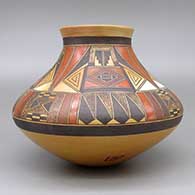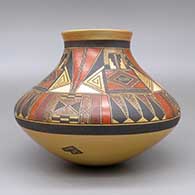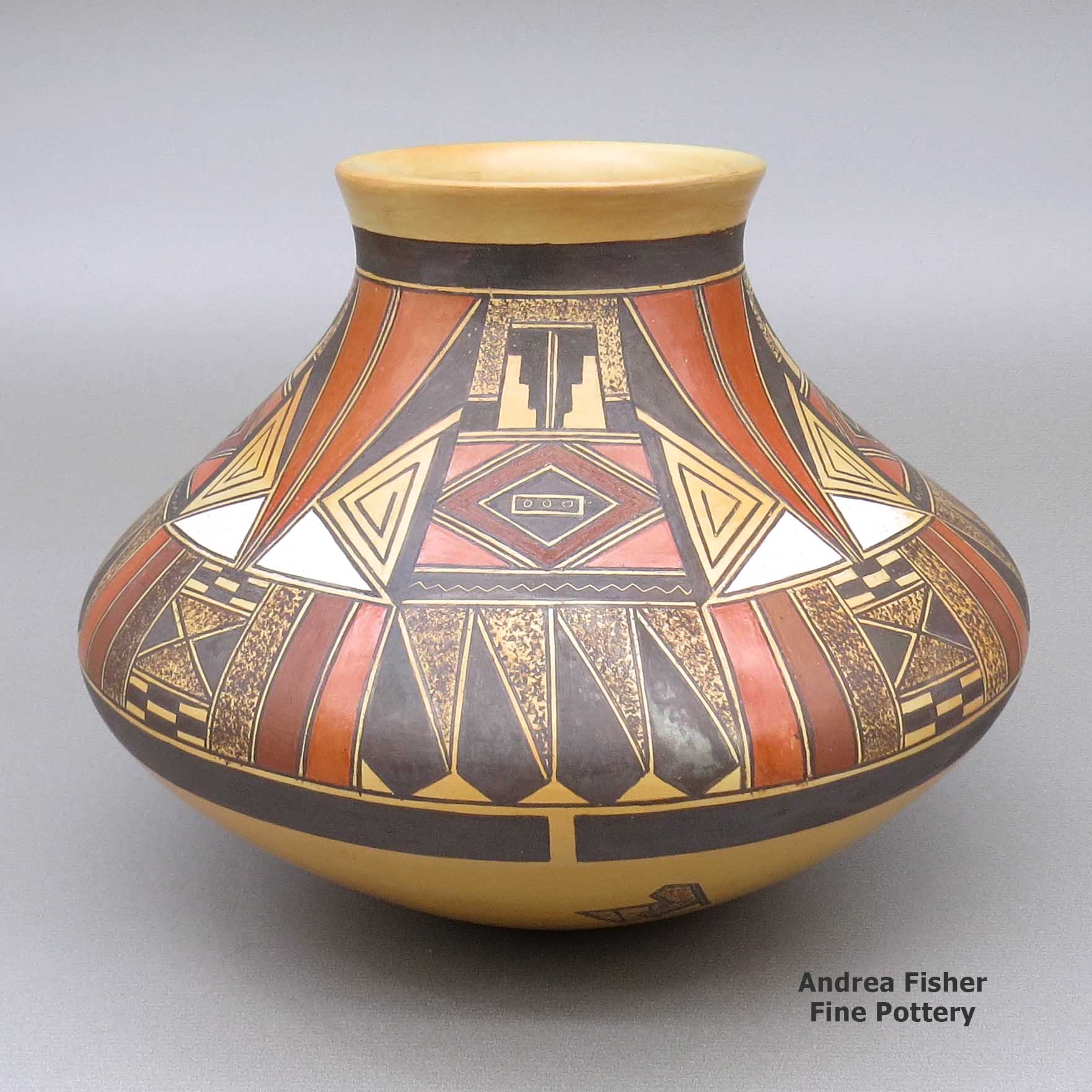
Hopi
$ 1575
spho3e160
Polychrome jar with a slightly flared opening, fire clouds, and a Sikyatki Revival broken shard and geometric design
6.5 in L by 6.5 in W by 5.25 in H
Condition: Very good, some rubbing on bottom and scratching on design
Signature: Karen Abeita, with hallmark
Tell me more! Buy this piece!
(505) 986-1234 - www.andreafisherpottery.com - All Rights Reserved
Karen Abeita
Hopi
"Here I was surrounded by rows and rows of shelves loaded with pottery from Sikyátki. I took out my sketch book and a pencil, quickly sat down and began copying designs. I applied to the biggest Indian art show in North America, the Santa Fe Indian Market, and was selected as one of the upcoming new artists from among several hundred applicants. I knew in my mind that there was no turning back." - Karen speaking of time she spent at the Philadelphia Museum of Art
In 1960, Karen Abeita was born in an Albuquerque hospital to a Hopi-Tewa woman named Lenora Nahoodyce Abeyta. Lenora had married an Isleta Pueblo man named Isidor Abeita, Sr. and moved from Hopi to Isleta Pueblo (which move was counter to tradition) but she returned to Hopi after Karen's birth.
Karen grew up in a traditional Hopi-Tewa home, a member of the Kachina/Parrot clan. She still lives a very strong traditional life where she speaks her native tongue and actively participates in tribal dances and ceremonies.
Karen says she has been a potter since she could first reach her hands into the clay bucket. Her grandmother, Mamie Nahoodyce, and her great-aunt, Patty Maho, and great-grandmothers, Po'Tsah-Weh, Pong Sayah, Kweh-Kah and several other aunts, Joy Navasie, Beth Sakeva and Sadie Adams, were all well respected potters.
Karen, however, credits her childhood friend, Fawn Navasie, with being her primary teacher. With her expertise and patience, Fawn taught Karen how to mold large pots, how to fire using sheep manure and, most of all, how to respect the clay and never forget to pray. She also believes that putting your heart and mind into what you are creating is the ultimate reward in the end because in front of your eyes is something you've created.
Karen says she thanks the clay for letting her be who she is. Her pottery is all hand coiled. The only tool she uses is a piece of gourd to shape her pots. Her pots range from 3 inches by 2 inches to almost 24 inches in diameter and 18 inches in height.
The painting is done with brushes made from the yucca plant and the paint is made from the mustard seed plant. The boiled-down paint is poured onto a painting stone and rubbed back and forth to mix with black hematite. The painting is one of the most important procedures. An artist can paint the most beautiful design on pottery but if the paint wasn't mixed properly, it will all rub off.
After the painting is complete, the pottery is then fired outside with sheep manure. This can take up to 6 hours so patience is key. Cooling off too quickly or uncovering too soon will result in the pottery cracking. Karen prefers to allow the pots to cool slowly, taking most of a day, unless she does the firing in the evening and uncovers the pots the next morning.
The designs Karen paints on her pottery are usually near-duplicates of designs she's found on pot shards from the ancient village of Sikyátki. Today, Sikyátki is barely mounds of stone and dirt where the ground is littered with thousands of broken pottery shards. To Karen, the ruins are a gold mine. She says she has never seen duplicates of the same design. She also says she loves to stand on the highest point in the ruin and let her imagination free to take her back in time to when the village was alive.
"What did a potter feel like when she was uncovering her just-fired pot? Was she excited? Did everyone in the village come to see the latest masterpiece?"
Karen says when she makes her journey to the ruins, she prays, then walks around and draws whatever designs she sees among the broken shards. After filling several pages with designs, she goes home and begins to paint what she calls "a shard pot."
A shard pot can consist of hundreds of designs, none of them ever the same size, shape or style. It is also very time consuming to paint: a small shard pot can take eight days from sun up to sun down to finish painting. It is a style she has worked long and hard to create and it still continues to evolve as she finds new potsherds with new designs.
Her pottery has taken her to many places. By invitation, Karen went to see the large collection of Sikyátki pottery in the vaults of the Philadelphia Museum of Art. Previously she had only seen complete Sikyátki pottery in pictures so seeing actual pots that had been made and used about two miles from her home in the early 1300s was like a direct connection from the past to the present.
All the hard work and long hours were about to pay off. She soon proved to herself and the world that she, too, is an excellent traditional potter.
Since then Karen has participated in more than 20 Santa Fe Indian Markets and has earned numerous awards, including the prestigious Helen Naha Memorial Award. She has also earned a First Place ribbon for Traditional Pottery at the Eiteljorg Museum in Indianapolis.
Knowing that only the very best earn the Helen Naha award and are counted in the company of award-winning Hopi-Tewa potters like Rondina Huma, Steve Lucas, Mark Tahbo, Rainy Naha and Dianna Tahbo, Karen feels that she has achieved a major goal in her life. Another goal she set for herself is to put all the designs she has collected from the ruins of Sikyátki in a book.
Karen currently lives in the village of Polacca on the Hopi Reservation with her husband Darryl Daw.
Some Awards Karen has Earned
- 2020 Heard Museum Guild Indian Fair & Market, Classification II - Pottery, Division A - Painted, native clay, hand built, fired out-of-doors: Second Place. Awarded for artwork: "For the Love of Dragon Flies"
- 2018 Santa Fe Indian Market. Helen Naha Memorial Award. Southwestern Association for Indian Arts
- 2017 Santa Fe Indian Market, Classification II - Pottery, Division B - Traditional, Category 601 - Painted polychrome pottery in the style of Hopi, any form: Second Place
- 2016 Heard Museum Guild Indian Fair & Market, Classification II - Pottery, Division A - Traditional, native clay, hand built, painted: Second Place
- 2015 Heard Museum Guild Indian Fair & Market, Classification II - Pottery, Division A - Traditional, native clay, hand built, painted: First Place
- 2010 Santa Fe Indian Market, Classification II - Pottery, Division B, Category 501 - Painted polychrome in the style of Hopi, any form: First Place
- 2002 Heard Museum Guild Indian Fair & Market, Classification VIII - Pottery, Division A - Traditional: Best of Division. Awarded for artwork: "Shards, Shards, Shards"
- 2001 Santa Fe Indian Market, Classification II - Pottery, Division F - Traditional pottery, Category 1302 - Other bowl forms: Third Place
- 2001 Santa Fe Indian Market, Classification II - Pottery, Division E - Traditional pottery, jars painted designs on matte or semi matte surface, Category 1201 - Jars, Hopi: Third Place
- 2000 Santa Fe Indian Market, Classification II - Pottery, Division J - Pottery Miniatures, 3" or less in height or diameter, Category 1605 - Traditional forms, other bowls: Third Place
- 2000 Santa Fe Indian Market, Classification II - Pottery, Division E - Traditional pottery, jars painted designs on matte or semi matte surface, Category 1201 - Jars, Hopi (up to 6" tall): Third Place
- 2000 Santa Fe Indian Market, Classification II - Pottery, Division F - Traditional pottery, Category 1302 - Seed bowls (over 7" in diameter): Third Place
- 1999 Santa Fe Indian Market, Classification II - Pottery, Division E - Traditional pottery, jars, painted designs on matte or semi-matte surface, Category 1201 - Jars, Hopi (up to 6" tall): Second Place
- 1999 Santa Fe Indian Market, Classification II - Pottery, Division F - Traditional pottery, painted designs on matte or semi-matte surface, all forms except jars (in the style of Hopi), Category 1301 - Seed bowls (up to 7" in diameter): First Place
- 1999 Santa Fe Indian Market, Classification II - Pottery, Division F - Traditional pottery, painted designs on matte or semi-matte surface, all forms except jars (in the style of Hopi), Category 1302 - Seed bowls (over 7" in diameter): Second Place
- 1998 Santa Fe Indian Market. Pottery, Classification II - pottery, Division E - traditional pottery, jars..., Category 1201 - Hopi (up to 6" tall): Third Place
- Division J - Pottery Miniature, Category 1604 - traditional forms, seed bowls, other than black: First Place
- Classification II-Pottery. Division E - traditional pottery..., Category 1201 - Jars, Hopi: Third Place
- Division F - traditional pottery..., Category 1301 - Seed bowls: Third Place - 1997 Santa Fe Indian Market. Classification II - Pottery, Division I - Traditional..., Category 1301 - Seed bowls: First Place
- 1995 Santa Fe Indian Market. Hopi Jars: First Place
- Bowls over 6 inches: Second Place - 1995 Lawrence Indian Arts Show, Lawrence, KS. 3 dimensional (large Hopi jar): Best of Show
- 1994 Santa Fe Indian Market. Category - Hopi Jars over 9 inches tall: First Place
- 1994 Gallup InterTribal Ceremonial. Category - Hopi Jars: First Place
- 1994 New Mexico State Fair. Category-Hopi Jars: Second Place
- 1993 Santa Fe Indian Market. Santa Fe, NM. Category 1443 Misc. Jars and Vases: First Place
- Hopi vases: First Place
- Cat., Seed Jar: Honorable Mention - 1992 Santa Fe Indian Market. Category 1401-Seed bowls. Second Place
Hopi

Tewa Village and First Mesa
The Hopi people live in villages on or around three primary mesas in northeast Arizona. Some of these communities have been continuously occupied since the 12th century. Because they lived in isolation longer than any other pueblo group, the Hopis retain much of their traditional religion, lifestyle and language. That said, the Hopi mesas have also long been sanctuaries for other tribes during times of great drought or great hardship (such as those brought on by the Spanish in the early years of their colonization of New Mexico). As a result, the landscape around First Mesa is littered with the remains of villages once founded by people speaking Keresan, Towa, Tewa and other languages.
The Hopi pottery tradition is quite varied with roots traced as far away as vitrified ceramics found in the environs of Valdivia, Ecuador, and produced between 1200 and 1500 BC. Archaeologists excavating in the ruins around First Mesa found shards of pottery styles and painted designs also found in the Rio Salado region and among the ancient Sinagua settlements in the Wupatki, Tuzigoot, Walnut Canyon and Homolovi areas (all abandoned between about 950 and 1200 AD).
The area around Jeddito was occupied by Towa-speaking people from the Four Corners region beginning around 1275. The Jeddito area is where Jeddito yellow is found, the clay that made the pottery of Sikyátki so spectacular.
Beginning in the 1400's, Keres-speaking people arriving from the east began to build what became Awatovi, on Antelope Mesa between Jeddito and First Mesa. Sikyátki itself was also built by people from the east beginning in the early 1300's. At first Sikyátki was inhabited solely by the Kokop (Firewood) clan, then the Coyote clan came and grew to become the largest single clan in the village. Why the village was destroyed is shadowed in myth but Jesse Walter Fewkes (the first archaeologist to excavate in the Sikyátki area) felt the village was destroyed before the first Spanish visitor arrived in 1540. Oral history has it that Sikyátki and its people were wiped out but the clans that lived in the village have somehow continued to exist. Modern dating techniques have set the destruction of Sikyatki around 1625.
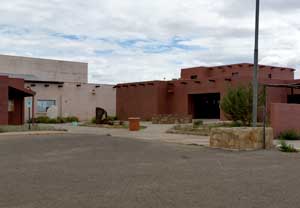
The Hopi Cultural Center
The ruins at Awatovi (on Antelope Mesa, east of Walpi and south of Keams Canyon) have yielded pottery shards in styles and with designs that were also prominent in the prehistoric village now known as Pottery Mound (in central New Mexico). Among the pot shards found at Pottery Mound are plain and decorated Hopi products, white clay products from the Acoma-Zuni area and red clay products from north-central New Mexico. Pottery Mound was abandoned about 100 years before the Spanish arrived in New Mexico in 1540.
It has been reported that many of the residents of Awatovi were Keres-speaking people from the Laguna-Acoma area (where Pottery Mound is) and, as such, were not as resistant as the Hopi themselves were to the Christianizing practices of the Spanish Franciscan monks when they came into the Hopi lands around 1609. As Awatovi was the only pueblo in the Hopi region to construct a Christian mission, most archaeologists attribute that to the reason why residents of Walpi and Old Oraibi destroyed the village and killed nearly all its residents in the winter of 1700-1701. However, at the time of that destruction, Awatovi was the largest and most populous pueblo in the Hopi mesas. It was also around 1690 that the people of Walpi were relocating from their old pueblo at the foot of First Mesa to their new location atop the southernmost finger of First Mesa, a move made for defensive reasons.
Southern Tewa warriors and their families (mostly from the Galisteo Basin and the area south of Santa Fe) began arriving in the area in 1696 and were steered to take up residence at the foot of First Mesa along the only route to the mesa top (in that location, the Tewas would be the first people to encounter incoming Spanish military - the people of Walpi felt they would make a good first line of defense should the Spanish attempt to reconquer them). The Tewas were also good at repulsing Ute, Paiute and Navajo raiders. After they won a decisive battle with Ute raiders they were allowed to build Tewa Village (also known as Hano) at the gap between the rocks on the trail up First Mesa. Some of the Tewa women were potters and in the ages-old way, they slowly shared what they knew with Hopi potters, and vice versa. That cross-pollination went on for years, and not just with pottery. Cross-cultural marriages happened, too, and today the people are known as Hopi, Hopi-Tewa and Tewa, depending on their ancestry. And while Tewa Village is completely surrounded by the Hopi Reservation, many of the residents are fluent in Tewa, Hopi and English. Some are fluent in Spanish and Navajo, too. There is a tribal injunction against any Hopi speaking Tewa, they may understand what is being spoken in Tewa but they are not allowed to speak Tewa themselves.
During those same troubled times Towa-speaking people from Jemez Pueblo migrated to Hopi and Navajo territory (in the Jeddito Wash area) to escape the violence of the Spanish reconquest. They established familial ties that are still in place today (which may explain why Jeddito Wash is a Navajo Reservation area surrounded by the Hopi Reservation).
The village of Sichomovi on First Mesa was founded in the 1600's by members of the Wild Mustard Clan, Roadrunner Clan and others who'd come to the area from east of Santa Fe (Pecos Pueblo and the pueblos of the Galisteo Basin) via Zuni. They seem to have stopped at Zuni for a few years and assimilated somewhat. When they moved on to Hopi, there were quite a few Zunis among them, that's why the people of Walpi (and some from Zuni) refer to Sichomovi as a Zuni pueblo.
They arrived at Hopi around 1600 CE and became known as the Asa clan. They had traveled from the Abiquiu area through Santo Domingo, Acoma, Laguna and Zuni, picking up and dropping off people, technology and social practices along the way. Some settled at Awatovi while others continued to Coyote Spring (under the gap at First Mesa). They built a new pueblo where Hano now stands (it was known as Hano back then, too). A few years later drought and disease caused them to relocate again.
They went east to the Navajo settlements around Canyon de Chelly and most stayed there several decades before an argument with the Navajo caused some to either return to First Mesa or travel east to the Rio Grande Pueblos. The descendants of those who intermarried with the Navajo stayed with the Navajo and are now a numerous clan known as Kinaani (High-standing house).
Those who returned to First Mesa found Hano occupied by the newly arrived Southern Tewa. The Asa were given a strip of land on the east edge of the mesa to build on but soon after, many of them moved to Sichomovi and merged with clans there.
Around 1800 a period of severe drought caused many Hopis to migrate to Zuni territory and once the drought had broken, most returned to their ancestral lands. While at Zuni many Hopi potters picked up the Zuni method of white-slipping their pottery and continued to produce white ware after returning to Hopi. However, their quality wasn't nearly as good as that of Hopi pottery produced pre-1700.
The quality, styles and designs of Sikyátki had lived on in Awatovi pottery, although the potters of Awatovi were also enamored of using a white slip on top of the Jeddito clay base. The potters of Awatovi also introduced some new designs (the "Awatovi star" being one) but after the village was destroyed, very little of their knowledge and practice passed on. Hopi ceramics entered a virtual Dark Age for almost 200 years.
By the mid-1800's the Hopi pottery tradition had been almost completely abandoned, its utilitarian purposes being taken over by cheap enamelware brought in by Anglo traders. Hopi pottery production sputtered along until the late 1800's when one woman, Nampeyo of Hano, almost single-handedly revived it. Nampeyo lived in Tewa Village on First Mesa and was inspired by pot shards found among the nearby ruins of the ancient village of Sikyátki. Today credit is given to Nampeyo for fully reviving the Sikyátki style. She was so good that Jesse Walter Fewkes, the first archaeologist to formally excavate Sikyátki, was concerned that her creations would shortly become confused with those made hundreds of years previously.
Sikyátki pottery shapes are very distinctive: flattened jars with wide shoulders; low, open bowls decorated inside; seed jars with small openings and flat tops; painting methods of splattering and stippling and very distinctive designs. The Sikyátki style originally evolved when Keres and Towa-speaking potters from New Mexico got together with Water Clan potters from the Hohokam areas of southern Arizona and northern Mexico and they began working with clays found in the Jeddito area. Over the years other clans came to the area and made their own contributions to what we now know as "Sikyátki Polychrome." Accoding to Jesse Walter Fewkes, that merging of styles, techniques and designs created some of the finest ceramics ever produced in prehistoric North America.
Today's Hopi pottery tends to be a white, yellow, orange or buff colored background decorated with designs in red and black mineral paints. Painted designs tend to fill the entire space, often with an asymmetrical and symmetrical design. Most of the symbology painted on Hopi pottery is themed with "bird elements:" eagle tails, feathers, bird wings and migration patterns. Many Hopi, Hopi-Tewa and Tewa potters are members of the Corn Clan and their annual religious cycle revolves around the seasons of corn. The vast majority of today's Hopi pottery shapes and the designs painted on them are obvious descendants of the work of Sikyátki and Awatovi potters.



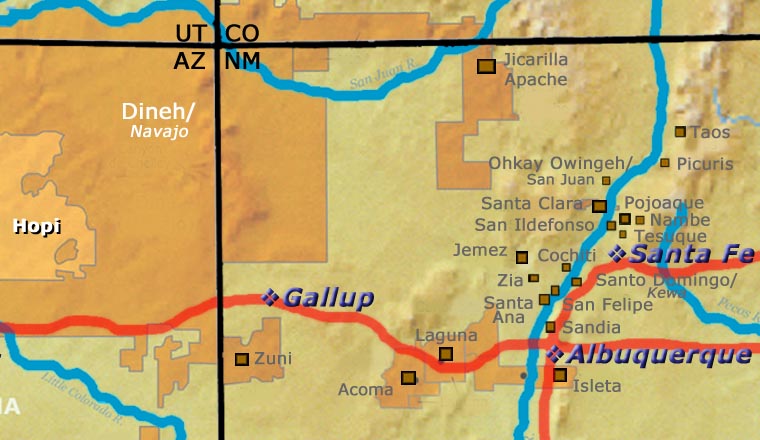
Hopi at Wikipedia
The Hopi Tribe official website
Prehistoric Hopi Pottery Designs, Jesse Walter Fewkes
Upper photos courtesy of TheArmchairExplorer, Creative Commons Attribution-ShareAlike 4.0 License
Lower photos courtesy of the Museum of New Mexico
Sikyátki Revival
Hopi
Les Namingha

White Swann
The name "Nampeyo" has been associated with much of the pottery produced on the Hopi Reservation in northeastern Arizona since the late 1800's. The potter, Nampeyo of Hano, just happened to be the right person in the right place at the right time. She re-interpreted and re-introduced various proto-historic forms, designs and color schemes, becoming the icon of a new/old approach to the making of pottery that was quickly adopted by other potters. This new style eventually came to be known as "Sikyátki Revival Ware", as it was associated with archaeological excavations that were conducted during the 1890s at the ruins of Sikyátki, the remains of a Hopi village which had existed between about 1375 and 1625 on the east flank of First Mesa. The ruins are about three miles north of Hano at First Mesa.
The common story is that Nampeyo's husband Lesou was hired by archaeologist Jesse Walter Fewkes in 1895 to help in the excavation of Sikyátki. As Fewkes told it, Lesou told Nampeyo about the pottery he'd seen at the site and his descriptions sparked her interest. She visited the site and saw first-hand the finely made, impeccably decorated jars and bowls that were being discovered and removed. Supposedly influenced by what she saw, Nampeyo’s work began changing to emphasize highly stylized bird forms, especially macaws and eagles. She also drew inspiration from other ancestral Hopi pottery types such as Jeddito and Awatovi Black-on-Yellows.
In reality, Lesou never worked for Fewkes and Nampeyo was well known for producing high quality Sikyátki Revival ware before Fewkes ever arrived in the area. No one called it that back then but it was what local traders like Thomas Keam and Lorenzo Hubbell were asking for when potters would bring them pots for sale. They wanted shapes, colors and designs like those that littered many of the old ruins in the area. The mounds at what were Sikyátki, Awatovi and Jeddito yielded many distinctive shapes and designs, long before Fewkes arrived.
Describing Sikyátki Revival Ware (or "Hano Polychrome," to be more accurate) is difficult. The pots are uniformly polychrome, employing vegetal and mineral paints that fire to become the reds, browns, yellows and blacks that we associate with Hopi pottery these days. The designs employ graceful, curvilinear lines that are well balanced across the three-dimensional surface of the pot. The designs also frequently incorporate religious symbols. The shapes are distinctive: wide shouldered flattened jars, low bowls with decoration inside and seed jars with small openings in their centers and tops that seem to defy the laws of physics as dictated by the clay. The base clays polish and fire to an unusually smooth texture, with colors ranging from golden yellow to orange to light brown. Since the fired surface came out so smooth, no slip had to be applied to the overall surface prior to applying the designs.
The pueblos of Hopi and Zuni had developed a close relationship in the 1860's when many Hopis left the Hopi mesas during a drought and a smallpox epidemic and waited at Zuni for conditions to improve so they could return. This connection influenced Hopi potters when they saw the Zunis use a white slip under their decorations. That practice returned to Hopiland when the potters returned and it was used in the production of "Polacca Ware," the most common form of Hopi pottery being made until the late nineteenth century. Polacca Ware is characterized by a white background with a "crackled" surface.
At the encouragement of local traders Thomas Keam and Lorenzo Hubbell, some Hopis started recreating old styles and designs based on the shapes and designs implied by ancient pot shards they found among the ruins left by their ancestors. Nampeyo was among the potters who were making quantities of non-utilitarian pottery for trade purposes and she heard Keam's call. Her innovation was to abandon the use of the white slip and apply her decorations directly to the polished clay body, just as she'd observed on the ancient pots. (The Navasie/Naha families still make their pottery using the white slip but now it's called "Walpi Polychrome.")
Nampeyo was relatively prolific in her making of pots. She also had an excellent eye for design and a steady hand for painting her designs. She and her descendants have set the quality bar for Sikyátki Revival (Hano Polychrome) pottery very high and that level of quality continues to rise today.
The tremendous diversity of design and technique in modern Hopi pottery stands as testament to its long history and the care with which today's Hopi and Hopi-Tewa potters seek to preserve their heritage while continuing to innovate and evolve the medium.
Tewa Kachina/Parrot Clan Extended Family Tree
Disclaimer: This "family tree" is a best effort on our part to determine who the potters are in this family and arrange them in a generational order. The general information available is questionable so we have tried to show each of these diagrams to living members of each family to get their input and approval, too. This diagram is subject to change should we get better info.
- Pong Sayah & Ahlong
- Lena Charlie (1888-1978) & Victor Charlie
- Sunbeam David & Randolph David
- Irma David
- Neil David Sr. (1944-) & Dealva David
- Neil David Jr.
- William David
- Sunbeam David & Randolph David
- Hazel & Edgar Shupla
- Beth Sakeva
- Kenneth Shupla (d. 1994) & Helen Shupla (1928-1985)(Santa Clara)
- Jeanne Shupla Komalestewa (d. 1989)(Santa Clara) & Alton Komalestewa
- Matthew Komalestewa
- Jeanne Shupla Komalestewa (d. 1989)(Santa Clara) & Alton Komalestewa
- Irene Shupla
- Mona Lee Youyetewa
- Lena Charlie (1888-1978) & Victor Charlie
- Quanka (Rainbow clan) & Ho'ni (Hopi, Snake clan)
- Sadie Adams (1905-1995) & Wilbur Adams (d. 1937)
- Riba Carr
- Lorna Lomakema (1930-) & Stetson Lomakema
- Cecilia Talas
- Wilbur Lomakema
- Sarah Crom
- Alice Hamilton
- Sadie Adams (1905-1995) & Wilbur Adams (d. 1937)
- Po'Tsah-Weh (Blue Water)
- Patty Maho (1903-1993) & Thorton Maho
- Mamie Nahoodyce (1906-1999) & Dennis Nahoodyce
- Lenora Nahoodyce Abeita & Isidor Abeita, Sr. (Isleta)
- Isidor Abeita, Jr. & Doreen
- Ervin Abaite
- Isidor Abeita III
- Kelsey Abeita
- Lenora Abeita
- Karen Abeita (1960-) & Darrell Daw
- Ronald Abeita & Ethelene
- Darrel Abeita
- Darren Abeita
- Evonne Pavatea & Calvin Pavatea
- Cornell Pavatea
- Dennis Pavatea
- Renalda Pavatea
- Thomas Pavatea
- Tocara Pavatea
- Isidor Abeita, Jr. & Doreen
- Geneva & Dick Pavatea
- Lenora Nahoodyce Abeita & Isidor Abeita, Sr. (Isleta)
- Paqua Sayah Naha (1890-1955) (Featherwoman)
- Susie Maha Youvella (1922-1995) & Charlie Youvella
- Wallace Youvella Sr. (1947-2021) & Iris Youvella Nampeyo (1944-)
- Charlene Youvella (1969-)
- Doran Youvella (1982-)
- Nolan Youvella (1970-2020)
- Wallace Youvella Jr.
- Wallace Youvella Sr. (1947-2021) & Iris Youvella Nampeyo (1944-)
- Stella Huma (1929-1995)
- Roberta Youvella Silas
- Jofern Silas Puffer
- Antoinette Silas Honie
- Daren Silas & Renee Silas Aguilar
- Louden Silas
- Louann Silas
- Venora Silas
Tsun Sayah
Some of the above info is drawn from Hopi-Tewa Pottery: 500 Artist Biographies, by Gregory Schaaf, © 1998, Center for Indigenous Arts & Studie. Other info is derived from personal contacts with family members plus interminable searches of the Internet and cross-examinations of the data found.
Copyright © 1998-2024 by


